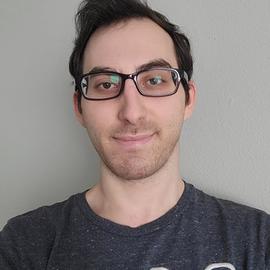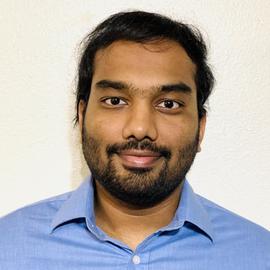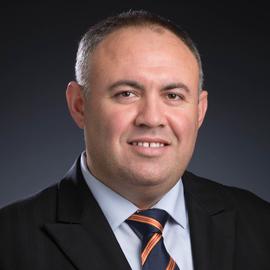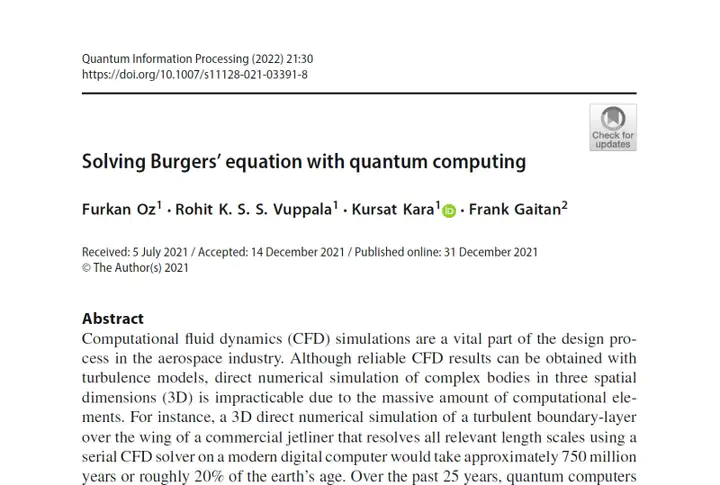Solving Burgers’ equation with quantum computing
Furkan Oz, Rohit Vuppala, Kursat Kara, Frank Gaitan
December, 2021
Abstract
Computational fluid dynamics (CFD) simulations are a vital part of the design process in the aerospace industry. Although reliable CFD results can be obtained with turbulence models, direct numerical simulation of complex bodies in three spatial dimensions (3D) is impracticable due to the massive amount of computational elements. For instance, a 3D direct numerical simulation of a turbulent boundary-layer over the wing of a commercial jetliner that resolves all relevant length scales using a serial CFD solver on a modern digital computer would take approximately 750 million years or roughly 20% of the earth’s age. Over the past 25 years, quantum computers have become the object of great interest worldwide as powerful quantum algorithms have been constructed for several important, computationally challenging problems that provide enormous speed-up over the best-known classical algorithms. In this paper, we adapt a recently introduced quantum algorithm for partial differential equations to Burgers’ equation and develop a quantum CFD solver that determines its solutions. We used our quantum CFD solver to verify the quantum Burgers’ equation algorithm to find the flow solution when a shockwave is and is not present. The quantum simulation results were compared to: (i) an exact analytical solution for a flow without a shockwave; and (ii) the results of a classical CFD solver for flows with and without a shockwave. Excellent agreement was found in both cases, and the error of the quantum CFD solver was comparable to that of the classical CFD solver.
Publication
Quantum Information Processing

Furkan Oz
Ph.D., Current Position: Oak Ridge National Laboratory

Rohit Vuppala
Ph.D., Current Position: University of Chicago

Kursat Kara
Associate Professor, Mechanical and Aerospace Engineering
Kursat Kara is an Associate Professor of Mechanical and Aerospace Engineering at Oklahoma State University and principal investigator of the Kara Aerodynamics Research Laboratory. His research spans hypersonic boundary-layer physics, unsteady aerodynamics, and the emerging interface of quantum computing and fluid dynamics. A dedicated educator and mentor, he teaches core and advanced courses—including Fundamentals of Aerodynamics, Computational Fluid Dynamics, Boundary-Layer Theory and Transition, and Quantum Computing—and supervises graduate and undergraduate projects in high-fidelity simulation and data-driven modeling. His work has been funded by NASA, NSF, Oklahoma NASA-EPSCoR, NAVAIR, ANSYS, and IBM Quantum. In 2025, he received the CEAT Excellent Faculty Award and was nominated for both the 2024 Excellent Teacher Award and the 2025 Excellent Faculty Award by OSU’s School of Mechanical and Aerospace Engineering. Dr. Kara earned his Ph.D. from Old Dominion University with a dissertation on hypersonic boundary layer receptivity to acoustic disturbances. He began his career as a research engineer at New England Analytics (supporting Sikorsky Aircraft), then completed a post-doctoral appointment at Penn State in hot jet simulations for aeroacoustics. In 2010, he helped establish the Aerospace Engineering Department at Khalifa University—where he won the President’s Faculty Excellence Award for Outstanding Teaching in 2015—before joining OSU. An active member of AIAA and APS, he served on the AIAA Applied Aerodynamics Technical Committee (2012–2021) and chaired/co-chaired multiple AIAA conferences. He also sits on the editorial board of Nature Scientific Reports and guest-edits its Quantum Computing collection.
